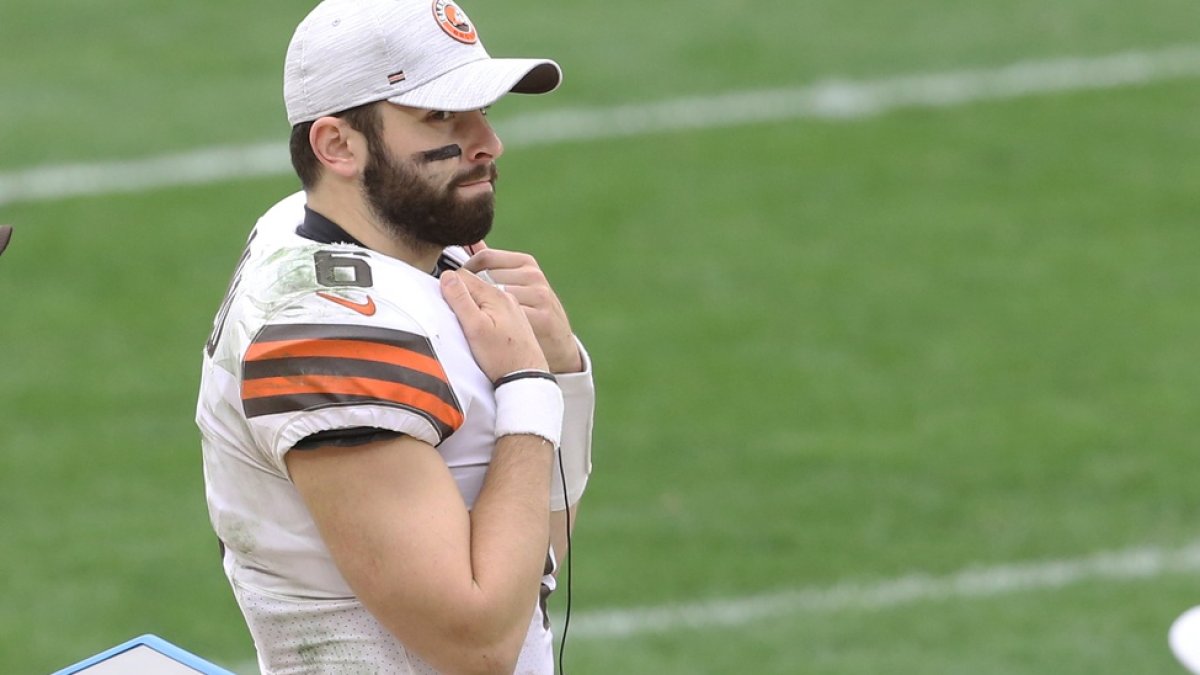For the last year and a half, I’ve repeated one question almost instinctively when asked about Cleveland Browns quarterback Baker Mayfield: “Who at the quarterback position peaked in their first year?”
Outside of injury-addled quarterbacks like Robert Griffin III, you’d be hard-pressed to find many more examples. But after a year and a half of not only not progressing but also regressing in key aspects of the position, it’s time to add Mayfield as an answer to that question.
While Browns head coach Kevin Stefanski insisted that Mayfield’s benching Sunday was purely for health reasons after the quarterback entered the game with a chest injury, that same injury can’t be used as an excuse for his disastrous performance. That’s because — as we’ve seen all season — Mayfield’s issues extend far beyond getting the ball from Point A to Point B (and even that hasn’t been a given).
In the words of PFF’s Seth Galina, a former quarterback coach in his own right, “the confident quarterback we saw in 2018 no longer exists.”
This is evident in a number of different ways. It’s in his shaky pocket presence where he went from being charged only 15 pressures as a rookie to 32 last season and is now on pace for even more than that this year. You can also see it in him holding the ball more, with his average time to throw climbing from 2.66 seconds as a rookie to 2.74 in 2019 to 3.08 in 2020. However, nothing exemplifies his waning confidence more than his performance down the field on traditional dropback passes. If you take away play action, here are Mayfield’s stats in each year of his career on passes thrown 10 or more yards downfield.
Mayfield: Passing stats on 10-plus-yard passes (2018-19, play-action passes excluded)
| Stat | 2018 | 2019 | 2020 |
| PFF grade | 91.2 | 75.1 | 50.8 |
| Adjusted comp. % | 54.2% | 47.9% | 48.6% |
| Big-time throws/turnover-worthy plays | 30/8 | 14/9 | 2/4 |
| Yards per attempt | 9.6 | 8.2 | 7.3 |
| Passer rating | 83.0 | 59.4 | 56.1 |
| % of dropbacks | 27.1% | 23.6% | 18.7% |
While it’s a small fraction of his total number of dropbacks, it’s almost wholly indicative of his decline. He’s not only been erring more on those throws, but he’s also not even finding those opportunities as frequently.
The last row in the table above is far and away the most concerning. His 144 10-plus-yard pass attempts as a rookie were the fifth-most in the NFL — and he didn’t even start the whole season. That number was the same as Patrick Mahomes, and the quarterbacks ahead of him were Ben Roethlisberger, Andrew Luck and Philip Rivers. And that's one of the many reasons why he impressed as a rookie — being able to find opportunities down the field is a tenet of quality quarterback play.
As Galina so eloquently said, though, that guy is gone. His 35 such attempts this season ranks 21st in the NFL. Of quarterbacks who have played six games already this season, only Jared Goff has fewer.
RPOs, play-action and screen passes rarely do you any good when trailing in games or in end-of-half situations. You have to be able to attack downfield on dropback concepts, and Mayfield has been nothing short of a liability when asked to do so so far this season.
Bad interception for Baker #ForTheShoe #Browns pic.twitter.com/0G1FRsMvNP
— Roto Street Journal (RSJ) (@RotoStJournal) October 11, 2020
So what’s the “fix” for the former No. 1 overall pick? The answer to that would be better answered by Mayfield, Stefanski or a sports psychologist. However, it doesn’t take the latter to realize that the problem with Mayfield's play over the last year and a half is just as mental as it is physical.
While the Browns' four-game winning streak masked Mayfield’s 66.3 passing grade over that span, it’s impossible to mask where Mayfield has struggled when the Browns have to play catchup. If that doesn’t change soon, the Browns can’t be considered serious contenders in the AFC.




 © 2025 PFF - all rights reserved.
© 2025 PFF - all rights reserved.